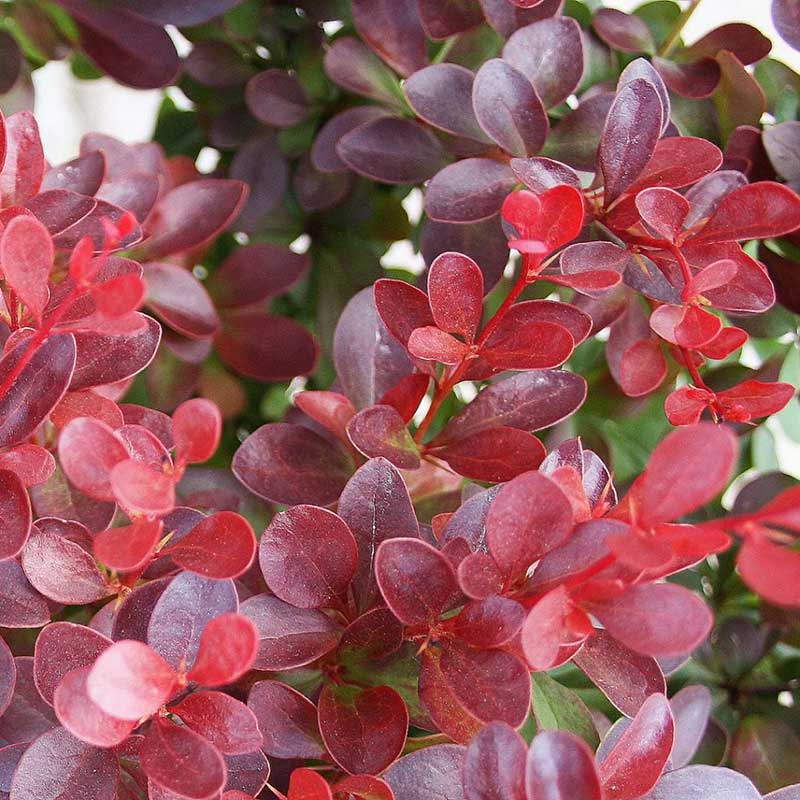berberis
Barberry – Berberis varieties
Barberry (Berberis) is a versatile and hardy genus of shrubs known for their vibrant foliage, spiny branches, and small, colorful berries. These plants are popular in landscaping due to their adaptability, low maintenance, and ability to thrive in a variety of conditions. Barberries come in numerous species and cultivars, with foliage ranging from green to deep purple or golden yellow, and they often display striking seasonal changes—think fiery reds and oranges in autumn. They produce small, bright berries (usually red, blue, or black) that attract birds, adding ecological value to gardens. Barberries are also drought-tolerant once established and can handle poor soils, making them a go-to for tough spots.
Their prickly nature makes them excellent for hedges or defensive barriers (nature’s barbed wire!), and they’re resistant to deer in most areas. Common species include Berberis thunbergii (Japanese barberry), Berberis vulgaris (European barberry), and Berberis darwinii (Darwin’s barberry), each with unique traits like size or berry color. They typically prefer full sun to partial shade and well-drained soil, though they’re not fussy about pH.
Best Companion Plants for Barberry
Choosing companions for barberry involves considering their aesthetic appeal, growth habits, and site preferences. Here are some top picks:
Ornamental Grasses (e.g., Panicum virgatum or Miscanthus sinensis)
The soft, flowing texture of grasses contrasts beautifully with barberry’s rigid structure and bold colors. For example, a purple barberry paired with the silvery plumes of maiden grass (Miscanthus) creates a dynamic visual.
Conditions: Grasses also love sun and tolerate drought, aligning with barberry’s needs.
Lavender (Lavandula)
Lavender’s silvery-green foliage and purple blooms complement barberry’s hues (especially yellow or purple varieties). Plus, both are drought-tolerant and thrive in sunny, well-drained spots. The combo also smells amazing and attracts pollinators.
Conditions: Full sun, lean soil—perfect match.
Sedum (Stonecrop)
Low-growing sedums, like Sedum spectabile or Sedum ‘Autumn Joy’, add succulent texture and late-season blooms that pair well with barberry’s fall color show. Their understated form balances barberry’s boldness.
Conditions: Sun-loving and drought-tolerant, they’re easygoing neighbors.
Juniper (Juniperus)
Evergreen junipers provide year-round structure, while barberry adds seasonal flair. A creeping juniper under a taller barberry creates a layered look, and their prickly personalities get along.
Conditions: Both thrive in full sun and poor soil.
Spirea (Spiraea)
Spirea’s airy blooms and fine foliage complement barberry’s denser form. Varieties like Spiraea japonica with pink flowers pop against a golden barberry backdrop.
Conditions: Full sun to part shade, adaptable to most soils.
Tips for Planting Companions
Color Play: Match or contrast barberry’s foliage—purple barberries sing with yellow companions, while green ones pair well with reds or silvers.
Height and Texture: Use low growers (sedum, heuchera) at the base and taller grasses or shrubs nearby for depth.
Spacing: Barberries can spread (especially Japanese varieties), so give companions room to shine without crowding.
Barberry’s versatility makes it a garden MVP—whether you’re aiming for a wildlife haven, a low-water xeriscape, or a vibrant hedge. Pair it thoughtfully, and you’ve got a winning combo! Anything specific you’re planning for your garden?
Height: 18″ – 24″
Width: 24″ – 36″
Watering and soil: Moist, well drained.
Exposure: Full sun.
Varieties: Crimson Pygmy, Golden, Rose Glow, Sunjoy Mini Saffron, Sunjoy Neo, Sunjoy Sequins.
Image: Crimson Pygmy Barberry
See: Shrubs and Roses
Category: Sun Perennials – Sun Plants – Sunny Plants – Shrubs – Deciduous Shrubs – Barberry near me – Berberis

